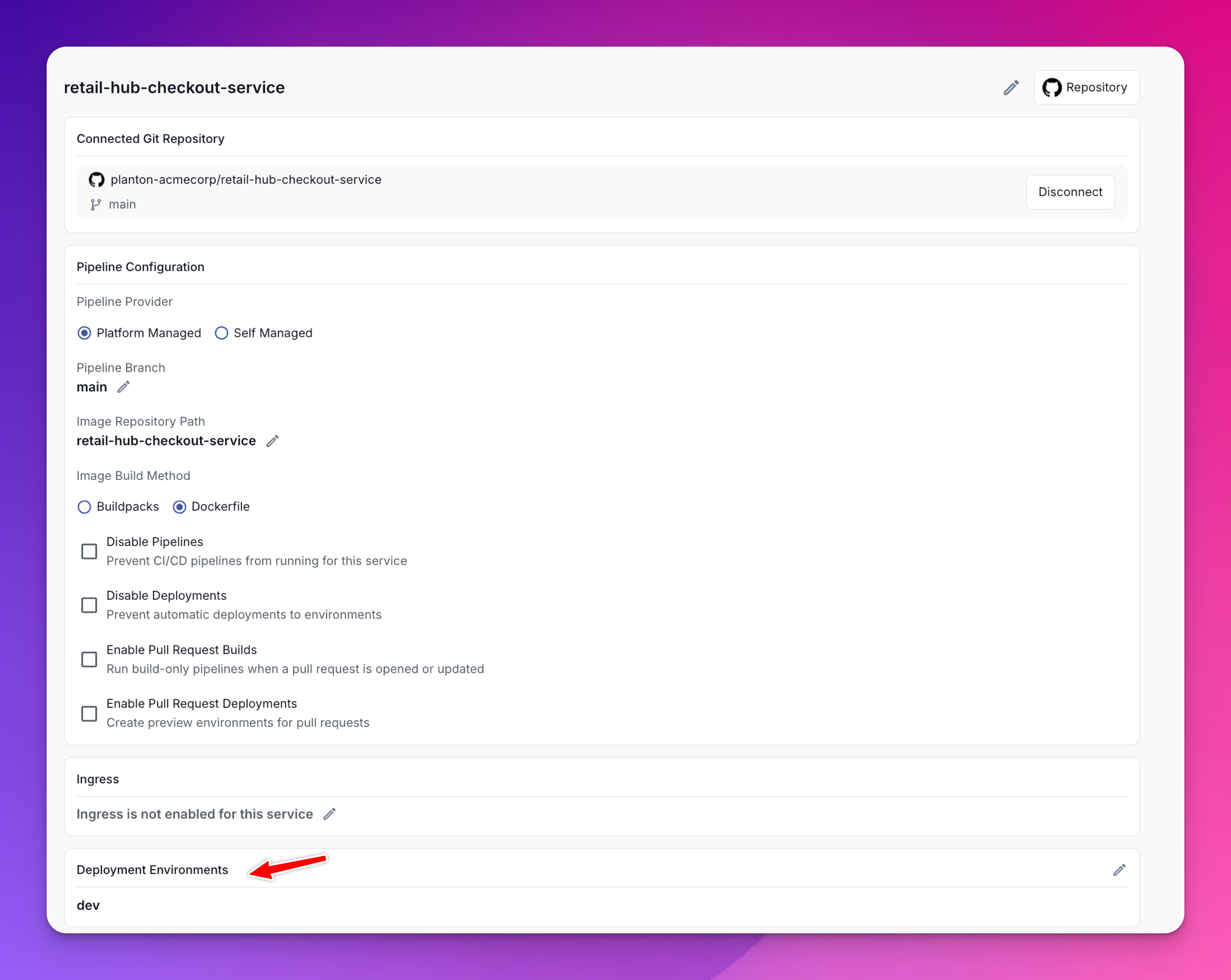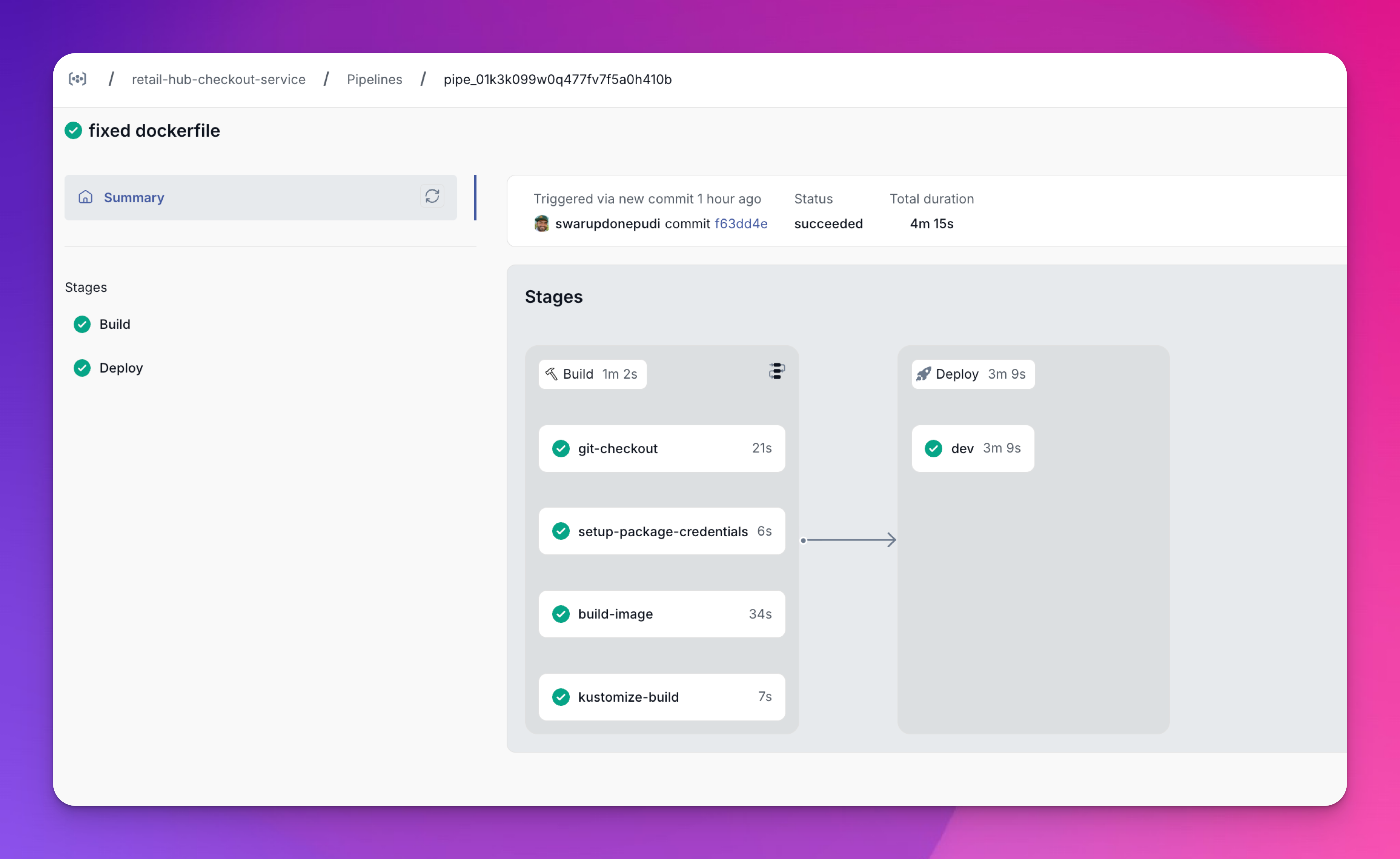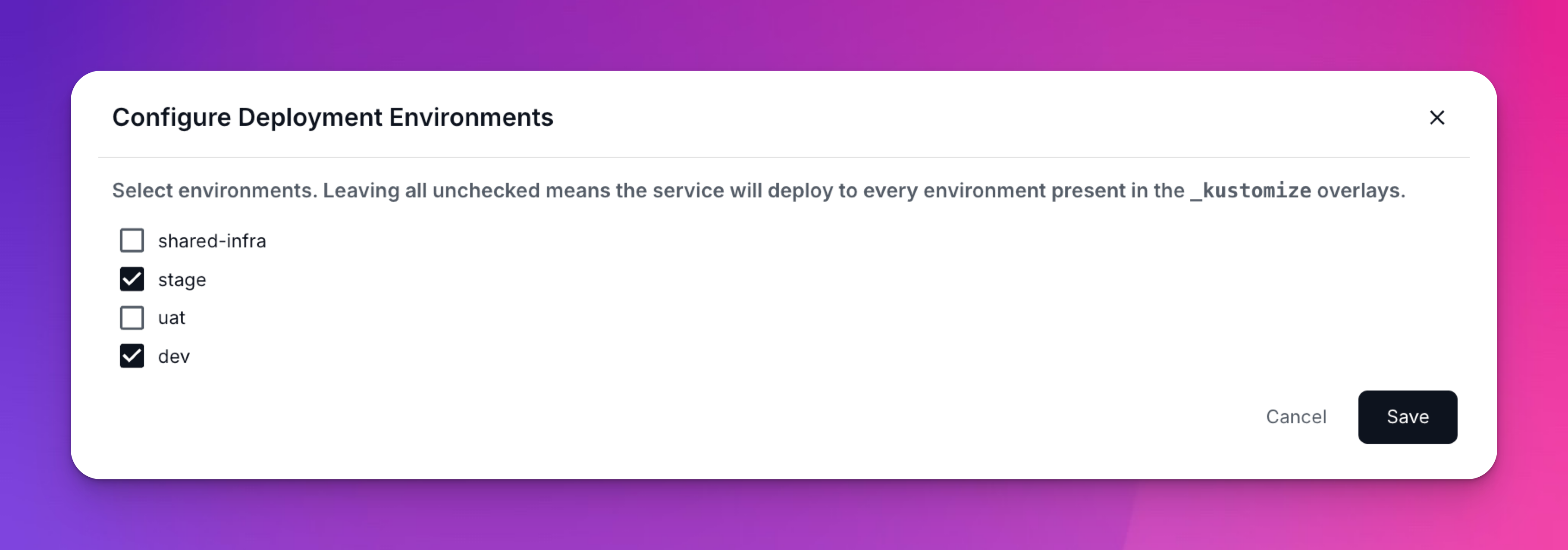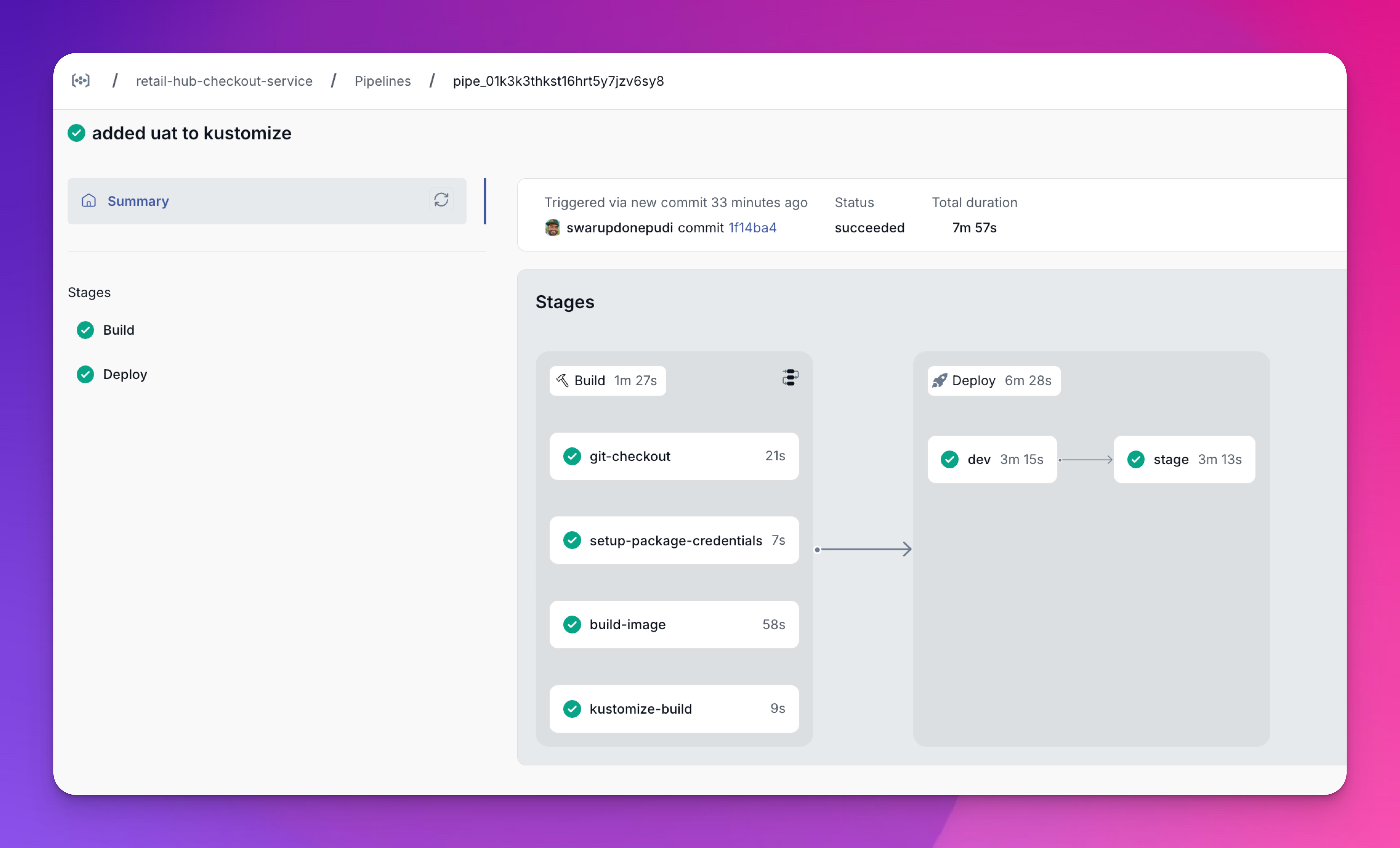Deployment Environments
Deployment Environments
Not every service needs to be everywhere. Sometimes your API should only deploy to production and staging, skipping the QA environment. Or maybe your experimental service should stay in development until it's ready. Planton Cloud gives you precise control over where your services deploy, while keeping your repository structure clean and conflict-free.
What You'll Learn
In this guide, you'll discover how to:
- Configure services to deploy to specific environments only
- Understand the relationship between _kustomize overlays and deployment environments
- Handle branch-based deployments without merge conflicts
- Use deployment environments for complex multi-environment setups
The Challenge: One Repo, Many Environments
Modern organizations often have multiple environments—dev, staging, UAT, production, and more. When using branch-based deployments, you might have:
- Different branches for different environments
- A need to keep all environment configurations in the repository
- Regular branch synchronization that creates merge conflicts
This creates a dilemma: How do you maintain configurations for all environments without deploying to all of them?
How Deployment Environments Work
Planton Cloud solves this with the deployment_environments field in your service specification. This field acts as a filter on your _kustomize overlay directories.
The Default Behavior
When deployment_environments is empty (the default), your service deploys to all environments found in your _kustomize overlays:
# Service spec - deploys to ALL overlays
spec:
deployment_environments: [] # or omit entirely
With this configuration, if your _kustomize directory has dev, stage, and uat overlays, the service deploys to all three.
Selective Deployment
To deploy only to specific environments, list them explicitly:
# Service spec - deploys ONLY to dev and stage
spec:
deployment_environments:
- dev
- stage
Now, even if your repository has dev, stage, and uat overlays, the service only deploys to dev and stage.

Understanding the Directory Structure
Let's look at a typical _kustomize structure with multiple environments:
_kustomize/
├── base/
│ ├── kustomization.yaml
│ └── service.yaml
└── overlays/
├── dev/
│ ├── kustomization.yaml
│ └── service.yaml
├── stage/
│ ├── kustomization.yaml
│ └── service.yaml
└── uat/
├── kustomization.yaml
└── service.yaml
Each overlay directory represents a potential deployment environment. The deployment_environments field determines which of these actually get deployed.
Base Configuration
The base contains common configuration shared across all environments:
# _kustomize/base/service.yaml
apiVersion: kubernetes.project-planton.org/v1
kind: MicroserviceKubernetes
metadata:
name: retail-hub-checkout-service
org: acmecorp
Environment Overlays
Each overlay patches the base with environment-specific settings:
# _kustomize/overlays/dev/service.yaml
apiVersion: kubernetes.project-planton.org/v1
kind: MicroserviceKubernetes
metadata:
env: dev
name: retail-hub-checkout-service
spec:
availability:
minReplicas: 1
container:
app:
ports:
- appProtocol: http
containerPort: 3000
name: rest
networkProtocol: TCP
servicePort: 80
resources:
limits:
cpu: 500m
memory: 500Mi
requests:
cpu: 50m
memory: 100Mi
version: main
Real-World Use Cases
Branch-Based Deployments
When using branch-based deployments, teams often face merge conflicts in _kustomize directories. The deployment environments feature solves this elegantly:
Scenario: You have branches for dev, staging, and UAT, each deploying to its respective environment.
Solution:
- Keep all overlay directories in all branches
- Create separate services for each branch-environment combination
- Configure each service to deploy only to its target environment
# checkout-service-dev (from dev branch)
spec:
deployment_environments:
- dev
# checkout-service-stage (from staging branch)
spec:
deployment_environments:
- stage
# checkout-service-uat (from uat branch)
spec:
deployment_environments:
- uat
This way, when branches merge, the _kustomize directories don't conflict, and each service still deploys only where intended.
Progressive Rollouts
Start with limited environments and expand as your service matures:
# Initial: Dev only
deployment_environments:
- dev
# After testing: Add staging
deployment_environments:
- dev
- stage
# Production ready: Full rollout
deployment_environments:
- dev
- stage
- prod
Environment-Specific Services
Some services should never deploy everywhere:
# Debug tool - dev only
deployment_environments:
- dev
# Canary service - staging first
deployment_environments:
- stage
# Legacy migration - specific environments
deployment_environments:
- legacy-prod
- legacy-dr
How It Works in Pipelines
When a pipeline runs, it respects your deployment environment configuration:
- Build Stage: Completes normally, building your container image
- Deployment Task Creation: Only creates tasks for configured environments
- Selective Deployment: Skips environments not in the list

In this example, even though the repository has dev, stage, and uat overlays, the pipeline only creates deployment tasks for the configured environments.
Configuring Deployment Environments
Through the Web Console
- Navigate to your service
- Click on the deployment environments selector
- Choose which environments to deploy to
- Save your changes

Through the CLI
Update your service YAML:
apiVersion: service-hub.planton.cloud/v1
kind: Service
metadata:
name: checkout-service
spec:
deployment_environments:
- dev
- stage
# uat is omitted - won't deploy there
Apply the configuration:
planton apply -f service.yaml
Through API
The deployment_environments field is part of the ServiceSpec protobuf:
// From cloud/planton/apis/servicehub/service/v1/spec.proto
message ServiceSpec {
// ... other fields ...
// optional list of environments to which this service is configured to be deployed to.
// if this list is empty, service is deployed to all environments identified from _kustomize directory in the service repo.
// if this list is non-empty, pipeline orchestration will only deploy to the environments from _kustomize directory in the service repo matching this list.
repeated string deployment_environments = 6;
}
Best Practices
1. Start Permissive, Tighten Later
Begin with empty deployment_environments (deploy everywhere), then restrict as needed:
# Initial: Deploy to all overlays
deployment_environments: []
# Later: Restrict to specific environments
deployment_environments: ["prod", "stage"]
2. Document Your Strategy
Add comments explaining why certain environments are excluded:
deployment_environments:
- prod
- stage
# UAT excluded - separate service handles UAT deployments
# Dev excluded - using local development instead
3. Consistent Naming
Use consistent environment names across your organization:
- ✅ Good:
dev,stage,prod - ❌ Avoid:
development,dev-env,develop
4. Branch Strategy Alignment
If using branch-based deployments:
- Keep all overlay directories in all branches
- Use deployment_environments to control where each branch deploys
- Document the branch-to-environment mapping
Common Patterns
Single Environment Services
For branch-specific deployments:
# Service from 'develop' branch
deployment_environments:
- dev
# Service from 'release' branch
deployment_environments:
- stage
- uat
# Service from 'main' branch
deployment_environments:
- prod
Gradual Rollout
For new features or services:
# Week 1: Dev only
deployment_environments: ["dev"]
# Week 2: Add staging
deployment_environments: ["dev", "stage"]
# Week 3: Add UAT
deployment_environments: ["dev", "stage", "uat"]
# Week 4: Full rollout
deployment_environments: [] # All environments
Environment Groups
For services that deploy to related environments:
# API Gateway - all customer-facing environments
deployment_environments:
- prod-us
- prod-eu
- prod-asia
# Internal Tools - non-production only
deployment_environments:
- dev
- stage
- uat
Troubleshooting
Service Not Deploying to Expected Environment
- Check the overlay exists: Ensure the environment has a corresponding overlay directory
- Verify the environment name: Names must match exactly (case-sensitive)
- Review pipeline logs: Check if deployment tasks were created
All Environments Deploying Despite Configuration
- Ensure
deployment_environmentsis not empty in your service spec - Verify the configuration was applied successfully
- Check that you're looking at the right service
Pipeline Shows Different Environments Than Expected
Remember that deployment happens in stages:
- First, the build completes
- Then, deployment tasks are created based on your configuration
- The pipeline UI shows which tasks were actually created

Next Steps
- Learn about multi-environment strategies
- Configure environment-specific settings with Kustomize
- Set up branch-based deployments
See Also
Based on: planton.ai/workspace/transcripts/service-hub/service-environments.transcript.md
Source: planton-cloud/apis/cloud/planton/apis/servicehub/service/v1/spec.proto
